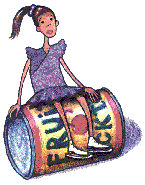|
|

By Dr. Leila Gonzalez
(and friends)
|
Note: This is a reprint of an article that originally appeared in the LA Times on April 15, 1999.
In our study of spinning
figure skaters we wanted to look at spinning without the effects of air
resistance. We made a comparison between skaters and rolling cans of
fruit cocktail. (You can look at previous articles in the Times building
in Whyville: www.whyville.net).
I went
to Mr. Castillo's and Mr. Hines' 5th period classes at Wilson Middle
School in Pasadena. We found that a frozen can rolled faster than an
unfrozen can 98 out of 102 times when measured at the end of the ramp.
This is what I thought would happen. I expected that in the unfrozen
can, the rolling would move the fruit to the sides of the can (does this really happen? see for yourself in this video), and
therefore, like the figure skater with arms extended, the unfrozen can
would spin slower. However, several of the students saw that the
unfrozen can actually started off rolling faster, even though it lost in
the end! It’s clear that something else is going on, so I asked
several physicists what they thought was happening:

Jerry Pine, Professor of Physics:
“This situation is much more complicated than the spinning skater.
When you roll down a ramp, you have two kinds of velocity: linear and
angular. This makes rolling more complicated than spinning. Plus the can
of fruit cocktail has liquid in it. Fluid motion is very complex.
I’d guess that the effect you see is due to fluid motion and not to
the pieces of fruit. Try it with cans of pure juice. If I'm right
you’ll see the same result.”
Don Skelton, Member of the
Professional Staff: “My guess is that the fruit cocktail cans
aren’t full. So, when you lay them on the ramp, the unfrozen can
has an air pocket at the top while the frozen can is more evenly
distributed. Because of the air pocket, the unfrozen can starts with
more of its mass closer to the ground and thus has a lower moment of
inertia than the frozen can. As it rolls, the cocktail gets
redistributed. It’d be fun to freeze one can of fruit cocktail
lying on its side and one standing up. If my idea is right, then the can
frozen on its side will start faster, like the unfrozen can.”
Alicia Alonzo, Applied Physics
Graduate Student, also thought that the difference in the cans might
have to do with the location of the (hypothesized) air bubble. But she
suggested a different test: Lay can #1 on its side and lay can #2
upright with the lid off and a fat marker in the center in order to
create an air pocket in the middle. Freeze them, then take the lid off
#1 and the marker out of #2 (so they are of equal weight). An unfrozen
can should roll like can #1 at the start and like can #2 at the end.
Another physicist (who requested
anonymity) said: “I've gotten similar results to the original
experiment by using frozen water. I think that the effect is due to the
difference between what is rotating at the start versus at the end. In
the frozen can, everything rotates from the start so the potential
energy is being used to roll the material inside. In the unfrozen can,
the inside material is not rolling at first, it’s just slipping, so
the potential energy is being used to roll the can. If the stuff inside
both cans is already swirling before the cans start to roll, then the
cans should roll the same. “
 |
Yikes! 4 different physicists, 3
different explanations, and 3 new experiments. Ahhh, science! If you
want to help figure this out, test these ideas and send me your results.
Right now, I’m going to the store for more fruit cocktail! (I also
have to pick up a few items for the new question we will look at next
week!) |
|
|